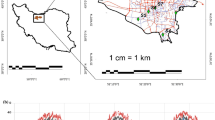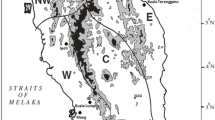Abstract
Ambient aerosol concentrations have been implicated in human health effects, in visibility reduction in urban and regional areas, in acid deposition and in perturbing the Earth’s radiation balance. The main concern of the air quality managers is to achieve compliance to the established air quality standards (AQS). As AQS are exceeded in numerous sites worldwide, it is essential to reduce the emissions. Having decided which statistical distribution fits well to the PM10 parent distribution, it is feasible to estimate the reduction in emissions that is required in order to meet AQS. In this study, it is verified that the PM10 concentration distribution can be adequately simulated by lognormal distribution, a conclusion drawn by the calculation of several statistical indexes. The study area is the city of Volos in central Greece, which is experiencing an unpleasant situation concerning the levels of PM10 pollution. The probability density function of lognormal distribution is capable to predict the number of days when the European Union (EU) AQS for PM10 concentration are exceeded in Volos area. Furthermore, the minimum reduction in current emission sources of PM10 required in order to meet the air quality regulations that are established by the EU is calculated for the study area and is found to be ~33%. The results could be utilized as reference for air pollution control strategy.


Similar content being viewed by others
References
Assael, M. J., Delaki, M., & Kakosimos, K. E. (2008). Applying the OSPM model to the calculation of PM10 concentration levels in the historical centre of the city of Thessaloniki. Atmospheric Environment, 42, 65–77.
Boy, M., & Kulmala, M. (2002). Influence of spectral solar irradiance on the formation of new particles in the continental boundary layer. Atmospheric Chemistry and Physics, 2, 1317–1350.
Colbeck, I., Meng-Chen, C., & Eleftheriadis, K. (2002). Formation and transport of atmospheric aerosol over Athens, Greece. Water, Air, & Soil Pollution. Focus, 2, 223–235.
Dockery, D. W., Schwartz, J., & Spengler, J. D. (1992). Air pollution and daily mortality: association with particulates and acid aerosols. Environmental Research, 59, 362–373.
Georgopoulos, P. G., & Seinfeld, J. H. (1982). Statistical distribution of air pollutant concentration. Environmental Science & Technology, 16, 401A–416A.
Giavis, G. M., Kambezidis, H. D., & Lykoudis, S. P. (2009). Frequency distribution of particulate matter (PM10) in urban environments. International Journal of Environment and Pollution, 36(1–3), 99–109.
Gwynn, R. C., Burnett, R. T., & Thurston, G. D. (2000). A time-series analysis of acidic particulate matter and daily mortality and morbidity in the Buffalo, New York, region. Environmental Health Perspectives, 108, 125–133.
Hennemuth, B., & Lammert, A. (2006). Determination of the atmospheric boundary layer height from radiosonde and lidar backscatter. Boundary-Layer Meteorology, 120(1), 181–200.
Johnson, N. L., & Kotz, S. (1970). Continuous univariate distributions. New York: Wiley.
Kambezidis, H. D., Peppes, A., & Melas, D. (1995). An experimental study in Athens area under sea breeze conditions. Atmospheric Research, 36, 139–156.
Kan, H. D., & Chen, B. H. (2004). Statistical distributions of ambient air pollutants in Shanghai, China. Biomedical and Environmental Sciences, 17, 366–372.
Kao, A. S., & Friedlander, S. K. (1995). Frequency distributions of PM10 chemical components and their sources. Environmental Science & Technology, 29, 19–28.
Katsouyianni, K., Touloumi, G., Spix, C., Scwartz, J., Balducci, F., Medina, S., et al. (1997). Short term effects of ambient SO2 and particulate matter on mortality in 12 European cities: results from time series data from the APHEA project. British Medical Journal, 314, 1658–1663.
Lammert, A., & Bösenberg, J. (2006). Determination of the convective boundary-layer height with laser remote sensing. Boundary-Layer Meteorology, 119, 159–170.
Lu, H. C. (2002). The statistical characters of PM10 concentration in Taiwan area. Atmospheric Environment, 36, 491–502.
Lu, H. C. (2003). Comparisons of statistical characteristics of air pollutants in Taiwan by frequency distribution. Journal of the Air & Waste Management Association, 53, 608–616.
Lu, H. C., & Fang, G. C. (2003). Predicting exceedances of a critical PM10 concentration—a case study in Taiwan. Atmospheric Environment, 37, 3491–3499.
Ma, C. C. Y., & Iqbal, M. (1984). Statistical comparison of solar radiation correlations—monthly average global and diffuse radiation on horizontal surfaces. Solar Energy, 33, 143–148.
Mage, D. T., & Ott, W. R. (1984). An evaluation of the method of fractiles, moments and maximum likelihood for estimating parameters when sampling air quality data from a stationary lognormal distribution. Atmospheric Environment, 18, 163–171.
Melas, D., Kioutsioukis, I., & Ziomas, I. (2000). Neural network model for predicting peak photochemical pollutant levels. Journal of the Air & Waste Management Association, 50(4), 495–501.
Ostro, B. D. (1990). Associations between morbidity and alternative measures of particulate matter. Risk Analysis, 10, 421–427.
Ostro, B. D., Chestnut, L., Vichit-Vadakan, N., & Laixuthai, A. (1999a). The impact of particulate matter on daily mortality in Bangkok, Thailand. Journal of the Air & Waste Management Association, 49, 100–107.
Ostro, B. D., Eskeland, G. S., Sanchez, J. M., & Feyzioglou, T. (1999b). Air pollution and health effects: A study of medical visits among children in Santiago, Chile. Environmental Health Perspectives, 107, 69–73.
Ott, W. R. A. (1990). Physical explanation of the lognormality of pollutant concentrations. Journal of the Air & Waste Management Association, 40, 1378–1383.
Papanastasiou, D. K., & Melas, D. (2009a). Climatology and impact on air quality of sea breeze in an urban coastal environment. International Journal of Climatology, 29, 305–315.
Papanastasiou, D. K., & Melas, D. (2009b). Statistical characteristics of ozone and PM10 levels in a medium sized Mediterranean city. International Journal of Environment & Pollution, 36(1/2/3), 127–138.
Seinfeld, J. H., & Pandis, S. N. (1998). Atmospheric chemistry and physics. From air pollution to climate change. New York: Wiley.
Stone, R. J. (1993). Improved statistical procedure for the evaluation of solar radiation estimation models. Solar Energy, 5(4), 289–291.
Taylor, J. A., Jakeman, A. J., & Simpson, R. W. (1986). Modeling distributions of air pollutant concentrations. I. Identification of statistical models. Atmospheric Environment, 20, 1781–1789.
Vardoulakis, S., & Kassomenos, P. (2008). Sources and factors affecting PM10 levels in two European cities: Implications for local air quality management. Atmospheric Environment, 42, 3949–3963.
Welty, L. J., & Zeger, S. L. (2005). Are the acute effects of particulate matter on mortality in the national morbidity, mortality, and air pollution study the result of inadequate control for weather and season? A sensitivity analysis using flexible distributed Lag models. American Journal of Epidemiology, 162, 80–88.
Acknowledgments
The authors would like to thank Mr. Stefanos Tzavelas who is the head of the pollution and the meteorological station, Department of Environment, Prefecture of Magnesia, Greece.
Author information
Authors and Affiliations
Corresponding author
Rights and permissions
About this article
Cite this article
Papanastasiou, D.K., Melas, D. Application of PM10′s Statistical Distribution to Air Quality Management—A Case Study in Central Greece. Water Air Soil Pollut 207, 115–122 (2010). https://doi.org/10.1007/s11270-009-0123-8
Received:
Accepted:
Published:
Issue Date:
DOI: https://doi.org/10.1007/s11270-009-0123-8




